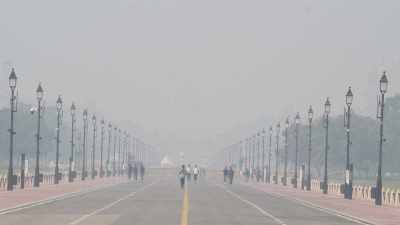When Ten Turns 14
It’s a five-place shift down the order but in cricketing terms it’s a 10 on the Richter scale. Sachin Tendulkar has dropped from 9...

It’s a five-place shift down the order but in cricketing terms it’s a 10 on the Richter scale. Sachin Tendulkar has dropped from 9 to 14 on the PriceWaterhouse Coopers ratings, the first time since its inception 10 years ago that he’s been out of the top 10. It is the statistical confirmation of what many have suspected: that the past couple of years haven’t seen the best of his batting in Tests.
It happens, coincidentally, at a time when his mates in the Indian middle order, Rahul Dravid and VVS Laxman, have found sparkling form. Are Tendulkar’s powers on the wane? Or is this only a bad patch? Or, again, is it just that the rest are finally pulling their weight?
First, the stats:
• The last of Tendulkar’s 31 Test centuries came more than a year ago, in the last Test of the 2002-03 West Indies series at home, when he scored 176 at Kolkata
• Since then, his sequence of scores in Tests (from New Zealand to Adelaide) has been 8, 51, 9, 32, 8, 7, 55, 1, 0, 1 and 37
• That’s 209 from 11 innings, at an average of 19.00
After first crossing the 50.00 mark in Tests — 1994, with the year’s average at 70.00 — Tendulkar has never fallen under (see graphic). In fact, he is still only marginally below Dravid. But, and this is telling, his yearly averages have dipped — from a phenomenal 80.87 in 1998 to 15.57 this year. Inversely proportionate to the rise of Dravid and Laxman.
Do the stats add up? No, says former India captain Chandu Borde, whose tenure as chief selector of the Indian team coincided with Tendulkar’s greatest years. ‘‘What you are seeing now is a normal batsman. He remains a great. He will always be a great. But now, because the pressure is off him somewhat, he can perform at a more relaxed level. He carried it (the expectations) all on his shoulders for many years. He’s due for a bit of rest. Don’t be judgmental at this stage. He’ll come back hard.’’
Why, then, is Tendulkar not being able to do what he once could? Former Australian captain Greg Chappell, a keen student of Indian batsmen, observes: ‘‘Sachin is weighed down by years of heavy expectations. He is struggling to overcome his own demons and is consumed by anxiety that is ruining his focus and concentration.’’
Chappell’s opinion finds an echo back home with former Indian opening batsman and coach Anshuman Gaekwad. ‘‘Sachin is building pressure on himself’’, Gaekwad says. ‘‘He sets very high standards for himself and living up to it is tough at times. It’s a failure if he scores 40. I have always maintained that it’s wrong to expect one man to do the job all the time. And it’s wrong that if Tendulkar plays well, India wins. It’s not like that. There will be phases when a batsman will fail. In Tendulkar’s case, it’s because the pressure is always too high and it hasn’t changed despite others doing well.’’
Former Indian captain Abbas Ali Baig says the same thing with a twist: Tendulkar is under ‘‘perceived pressure’’. ‘‘I think Tendulkar is trying too hard to live up to his perceived notion that he is the number one batsman in the team. It’s a mental thing. There are others staking a claim to his position, and he is trying too hard to hold on to the reputation.’’
Apart from the mind, anything wrong with the technique? He has, for example, got out leg before twice in Australia by shouldering arms. Baig disagrees. ‘‘No. He looks perfectly good on the crease. Those were just errors of judgment and nothing more. It happens. He is not enjoying himself at the crease. He is trying too hard and is not playing his usual free-flowing game.’’
‘‘There’s no apparent flaw’’, says former all-rounder Madan Lal. ‘‘He is a proven performer going through a lean patch. Give him time, things will get better.’’
That Tendulkar is not on the wane is most strongly borne out by his one-day record — as prolific as his Test record has been poor. Since 2001, he has played 58 ODIs, scoring 2786 runs at an average of 59.27. In that period, he has been man of the match on 12 occasions, and man of the series at the Coca Cola Cup in Zimbabwe, the England-India five-match series at home last year, the 2003 World Cup and the TVS Cup triangular tournament at home recently.
‘‘It’s very different in ODIs and the two can’t be compared,’’ Baig suggests. Lal agrees, saying, ‘‘If that were the case, then look at Saurav Ganguly. He’s been the number one ODI batsman for so long, but hasn’t done so well in Tests. Our debate is on Tests, and the two shouldn’t be mixed.’’
The net result, of course, is more important than the success-failure ratio of an individual. When it comes to that, Tendulkar’s slide hasn’t meant a slide for India. On the contrary, India is playing as well as it ever has. Maybe there’s also something to Baig’s argument that ‘‘Tendulkar’s only 31 or so, but don’t forget it’s been 14 years since he started. Let him have a rest. Let the others do it for a while. he’s done it alone for so many years. Let the others take centrestage now.’’
They have, spectacularly. But what if Tendulkar can also find his own exhilarating touch? Now there’s a bowler’s nightmare.





- 01
- 02
- 03
- 04
- 05


























